For ChessLecture fans, I have some good news, or at least interesting news. As I mentioned earlier, GM Jesse Kraai — the winner of the U.S. Championship Qualifier — offered to take a look at my games from this tournament and pick one as the topic for one of his lectures. He picked my game with John Bick, which was the subject of my most recent post. It will be extremely interesting to me to see what Jesse says and how his take on the game differs from mine (or not). Look for his lecture later this week.
But now let’s move on to the next round. As you may remember, this was the game where I had to play the dreaded King, Bishop and Knight versus King endgame (for the first time in my whole chess career). It was also the first time I have ever won a game that took more than 100 moves. But when you see this game, you might think that the most amazing thing was that I even survived past move 30! My position out of the opening was much worse than I realized. In a way, I think it’s good that I didn’t realize how busted I was. I kept on playing active moves and let the chips fall where they may. That’s probably a good lesson for playing any position where you are in trouble.
I was White, and my opponent, a teenager named Jacob Berger who is rated 1980 or so, was Black. The game began with an opening experiment: 1. e4 c5 2. f4 e6 3. Nf3 d5 4. Ne5!? This move is a violation of opening principles, because White moves the same piece twice in the opening. However, there are some tactical points to it, as we’ll see. I’m hoping Black will accept my Budapest-like gambit. But he doesn’t bite, and he plays the very sensible 4. … Nf6 5. Bb5+ Bd7 6. Nxd7 Nbxd7 (this may actually be a mistake) 7. e5 a6 (Note that if 7. … Ne4 immediately, White plays 8. Bxd7+ and Black has to take with the king or else his knight on e4 will be trapped! This is the first indication of Black’s tactical difficulties.) 8. Be2 Ne4.
Now I completely spaced out and played the horrible move 9. Bf3?? Of course I saw Black’s threat of 9. … Qh4+ followed by … Nxg3, but somehow I thought I was safe if I defended my rook. I forgot that Black could still sacrifice the knight and just win a bunch of pawns instead.
Ironically, I had analyzed this exact position at home a couple years ago. After 9. g3! White threatens d3, and Black has to walk a tightrope just to save his knight. The variation goes 9. g3 c4 (forced) 10. d3 cd (forced) 11. cd Qa5+ (forced; if 11. … Nc5? 12. b4) 12. Kf1! Nc5 13. Bd2 Qa4 (forced) 14. Nc3. Now Black’s response is not forced; he can play either 14. … Qxd1+ or 14. … Qc6. Either way it’s a very complicated position, but maybe a bit better for White.
After 9. Bf3?? you can probably figure out the next few moves without me telling them to you: 9. … Qh4+ 10. g3 Nxg3 11. hg Qxg3+ 12. Ke2 Qxf4 13. d4 Qxd4 14. Qxd4 cd 15. Bf4.
This position is the first of several where Berger let me off the hook. He plays a good move — 15. … Rc8, after which I thought for 21 minutes before deciding on 16. Kd3. But let’s think about what would have happened if Black had played 15. … f6 first. White is now forced to abandon his beachhead on e5, and that’s really bad news. For instance, if 16. Bh5+ Kd8 17. Bg6, Black simply plays 17. … fe 18. Bg5+ Be7 19. Bxe7+ Kxe7. And now it turns out that White can’t capture on h7, because he loses a piece! For instance, 20. Rxh7 Rxh7 21. Bxh7 Rh8 22. Bg6 Rh6 23. Bd3 e4.
The moral here is that Black played a finesse move when it would have worked just to bludgeon me over the head. After 15. … Rc8 16. Kd3 he continued 16. … f6, and now we go into exactly the same line as above, except that I now had the move Re1 available to defend my pawn on e5. (17. Bh5+ Kd8 18. Re1!) He continued 18. … Bb4, a good move, and instead of the forced 19. c3 I played 19. Re2?, which should have lost.
Once again, Black plays a finesse, 19. … Rf8?! But he should have socked me in the mouth with 19. …Rc4! The threat is … Nc5 mate, and the only way out for White is 20. c3 dc 21. bc Rxf4 22. cb Nxe5. Black now has five pawns for a piece (!), and this position should be a no-brainer.
Okay, let’s move ahead a few moves (if you’re keeping score, the moves were 19. … Rf8?! 20. ef gf 21. c3 dc 22. bc Be7 23. Nd2 e5 24. Bh2 Nb6?!) to the turning point in the game. Black’s last move was an inaccuracy; he should have played 24. … e4+ right away. I played 25. Rd1!, and now we see why Black missed his chance.
Now if Black plays his intended move, 25. … e4+, White sacs with 26. Nxe4! de 27. Kxe4+! In fact, this move is almost checkmate! Black has to give up a piece to escape. This brings up an interesting puzzle: I wonder if there has ever been a grandmaster game where one player delivered checkmate with a king move? Inquiring minds want to know! I think I may send this question to Tim Krabbe — it’s the sort of thing he would know.
Anyway, psychologically 25. Rd1! was a big moment for me. I have finally gotten my last piece into the action. And also, for the first time I have really landed a solid blow of my own: Black has to change plans. As it turned out, he found another good move: 25. … Na4, which threatens two different forks: … Nxc3 and … Nb2+. (Did you see this second one?) So I was forced to play 26. Nb1 again. But now this doesn’t bother me so much. The knight is a good defender here, and it’s no longer blocking White’s rook. For the first time, I really started to feel optimistic (probably a little prematurely, though).
Let’s skip ahead to the next key position. (If you’re keeping score, the moves were 25. Rd1 Na4 26. Nb1 Rc4 27. Rf1 Rh4?! 28. Rf5 Nc5+ 29. Kc2 Ne4 30. Bf3 Nd6 31. Rh5 Rxh5 32. Bxh5 Rg8? 33. Nd2? Note that White missed a chance to win back a pawn with 33. Rd2.)
The position is much trickier for Black than you’d think. At first glance, it seems as if Black controls the only open file, White’s bishops are struggling to find anything to do, Black has a rock-hard central pawn mass, and he is still up four pawns for a piece. In spite of all his missed opportunities to hammer White into submission, nevertheless Black has played sensible chess and should still have a strategic advantage.
However, let’s look a little bit closer. That “rock-hard” pawn formation actually has a very sensitive spot on d5, which Black has trouble defending. (In fact, White missed a chance to attack d5 last move.) After Bf3, Black will have to advance with … e4 and … f5. But this pawn formation, as the game shows, is exceedingly brittle. All the pawns are on white squares, and especially the f-pawn is subject to attack by Bf3-g2-h3, Nd2-b3-d4, and Rf2.
As it turns out, Black can keep the advantage by playing energetically with 33. … Rg5! The point is that after 34. Bf3 e4 35. Bg2 f5, White’s bishop cannot set up shop on h3, because 36. Bh3 is met by 36. … Rh5 (and if 37. Re3? Bg5.) Similarly, the other bishop cannot set up shop on f4, because 36. Bf4 is met by 36. … Rg4 (and if 37. Rf2? Bh4.) So White is forced into passive stuff like 36. Nb3 Nc4! (threatening … Rxg2!) 37. Bf1, and this cannot be good.
I’m not at all surprised that Black missed 33. … Rg5, because it required tricky tactical calculations, and we were now getting to a point where both players were low on time. Instead he plays the more routine move 33. … Kd7, but this turns out to be a very unfortunate square for his king. Now when White plays Bh3, he won’t just attack the f-pawn, he will pin it. The game continued 34. Bf3 e4 35. Bg2 f5 36. Nb3 Rf8?! (For the first time in the game, Black is forced to play an out-and-out defensive move. Probably 36. … Bf6 was better, setting up a counterattack on White’s weak c3 pawn.) 37. Bh3 Kc7 38. Nd4. Now things are really clicking for White. Although I’m low on time, each move is easy to find and now it is Black who is facing a bewildering variety of threats at every turn. I’m threatening a fork on e6, so Berger plays 38. … Kb6 39. Bxd6 Bxd6 40. Bxf5.
Hooray! After fighting uphill for 26 moves with a piece against four pawns, I have finally won back one of the pawns and I’m back to a “normal” material situation of a piece against three pawns. Not only that, Black’s whole rickety pawn structure is in danger of collapse. All of his pawns are on white squares, and he just can’t defend them.
If you’re wondering where Black actually lost the game, this is the move. According to the computer, Black can still draw with 40. … Be5! 41. Bxh7 Bxd4 42. cd Kb5. Although Black now has just two pawns for a piece, White cannot hold the pawn on d4, and so it will soon be back to three pawns for a piece. In fact, White’s most reliable way of drawing may be just to give the piece back with 43. Bxe4 de 44. Rxe4.
Psychologically, though, 40. … Be5 was next to impossible to find. Black is in time pressure, he sees that his pawn on h7 is threatened, and so the natural thing to do is move it. I doubt that he thought more than a few seconds before playing 40. … h5?, the losing move. But now the house of cards in the center comes crashing down: 41. Be6 Kc5 42. Nb3+! Kc6 43. Rd2! e3 44. Bxd5+. One more cute twist! White is able to win the pawn with a zwischenzug before moving his rook. 44. … Kd7 45. Re2 and the e-pawn is now doomed. Incredibly, Black’s three proud pawns in the center have been demolished, and of the four pawns he won for his knight, only the h-pawn will remain.
I could stop here, because at this point White is clearly winning. But I’m sure that some of you are wondering — how did we get from here to the K+B+N versus K endgame? Very well, I’ll show you one more position, after Black’s 58th move.
As you can see, White has won one of Black’s queenside pawns, but in so doing he has allowed Black’s king to penetrate deep into the kingside. Although Black’s h-pawn is securely blockaded by the knight on h3, it’s difficult to conceive of any way for White to force a win of the h-pawn. So instead White has to break through on the queenside. Here I played 59. Ke4. The plan was to play a2-a4, Ke4-d5-c6-b5, and finally push whichever pawn (a-pawn or c-pawn) was free. (It turned out to be the a-pawn.) Black was forced to trade pawns, giving me a passed c-pawn. Then I pushed the c-pawn, forcing the bishop to sacrifice itself. (Remember that Black’s king is on the kingside the whole time. If he had brought it to the queenside to stop the c-pawn, then I would have walked my king over to the kingside, freed the knight, and won the h4 pawn. Trust me on this.) Now we’re down to K+B+N versus K+P. With tempo moves I’m able to force his king away from the defense of the h-pawn, and that takes us down to K+B+N versus K. I won the pawn on move 74, and he resigned 30 moves later.
If you’re a masochist or you really want to study the K+B+N versus K endgame, here are the last 59 moves of the game. (Remember we were up to 45. Re2.) Actually, these moves have a certain documentary interest. Frank Berry, the tournament director, sent out a file with .pgn scores of many of the games from Tulsa. This game was in his file — but the moves from 88 on were bogus! I’m not sure how this could have happened; maybe someone reconstructed the finish on a computer. So here, and only here, you can see how the game really ended:
45. … Rf2 46. Kd3 Bg6 47. Kxe3 Rxe2 48. Kxe2 b6 49. c4 Bd6 50. Nd4 Ba3 51. Kd3?! (A time pressure inaccuracy; 51. Nf5 is much easier.) 51. … Kd6 52. Bb7 Ke5 53. Bxa6 Kf4 54. Bb7 h4 55. Ne2+ Kg4 56. Bc8+ Kf3 57. Ng1+ Kg3 58. Nh3 Bc5 59. Ke4 Bb4 60. a4 Bc5 61. Kd5Â Be3 62. Kc6 Kg2 63. Kb5 Kh2 64. a5 ba 65. Kxa5 Kg3 66. Kb5 Kf3 67. c5 Bxc5 68. Kxc5 Ke4 69. Kc4 Ke5 70. Kd3 Kd5 71. Ke3 Ke5 72. Kf3 Kd4 73. Nf4 h3 74. Bxh3 (The 50-move count begins.) 74. … Ke5 75. Ke3 Kd6 76. Kd4 Ke7 77. Ke5Â Kf7 78. Bf5 Kg7 79. Ke6 Kf8 80. Kf6 Kg8 81. Ne6 Kh8 82. Ng5 Kg8 83. Nf7 Kf8 84. Bh7 Ke8 85. Ne5 Kd8 86. Be4 Kc7 87. Nc4! Kd7 88. Kf7 Kd8 89. Bc6 Kc7 90. Bb5 Kd8 91. Ke6 Kc7 92. Ke7 Kc8 93. Kd6 Kd8 94. Ne3 (Avoiding 94. Ng6 stalemate.) 94. … Kc8 95. Nd5 Kd8 96. Bc6 Kc8 97. Nf4 Kb8 98. Kc5 Ka7 99. Kb5 Kb8 100. Kb6 Kc8 101. Ne6 Kb8 102. Bd7 Ka8 103. Nc5 Kb8 104. Na6+ resigns
[Note: Typo on move 81 fixed 4/10/08.]
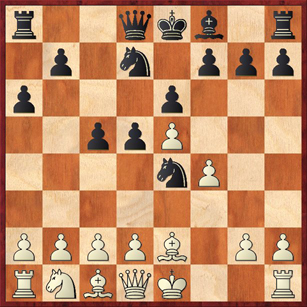
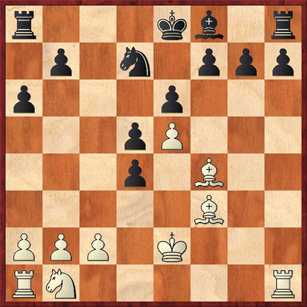
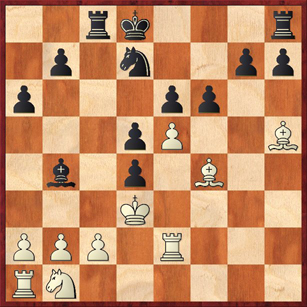
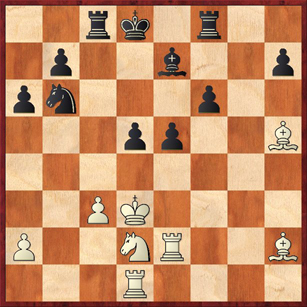
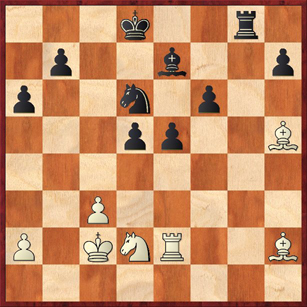
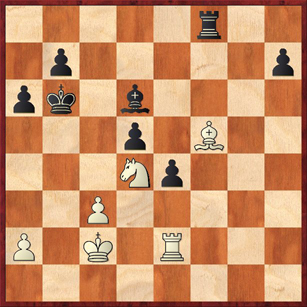
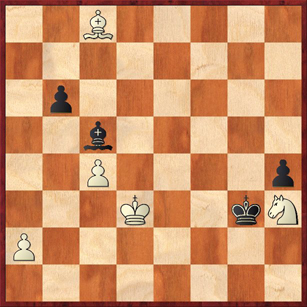



{ 4 comments… read them below or add one }
I actually was sitting next to Dana in this game and was following his game more intently than mine. I had a somewhat easier game on my board against a fellow (2135) from San Antonio who I had played once before.
I won and finished my game early so I never saw how this game ended. I was surprised to learn that he actually won it. I am sure it was a satisfying struggle for Dana.
Anyway, my blog with MonRoi debuted today. My chessville volumn (The Whites of Their Eyes) debuted the Monday before this past one, March 31st. I will be busy for a while but will continue to frequent this blog.
Andy
I found a problem with the game score when I tried to replay de game:
81. Ne6 Kf8 (it’s impossible)
Thanks, Masegui
Andy – Nice debut for both columns! Thanks for telling me where to look for your Chessville article. The layout of their site is rather confusing, so even though I had looked for your article before I wasn’t able to find it.
Masegui, Thanks for catching the typo! Also, welcome to the blog! I’m always glad to hear from a new reader. The correct move was 81. … Kh8. I’ll fix the original post so that other people won’t have the same confusion.
Thanks. I appreciate it especially coming from you.
{ 1 trackback }